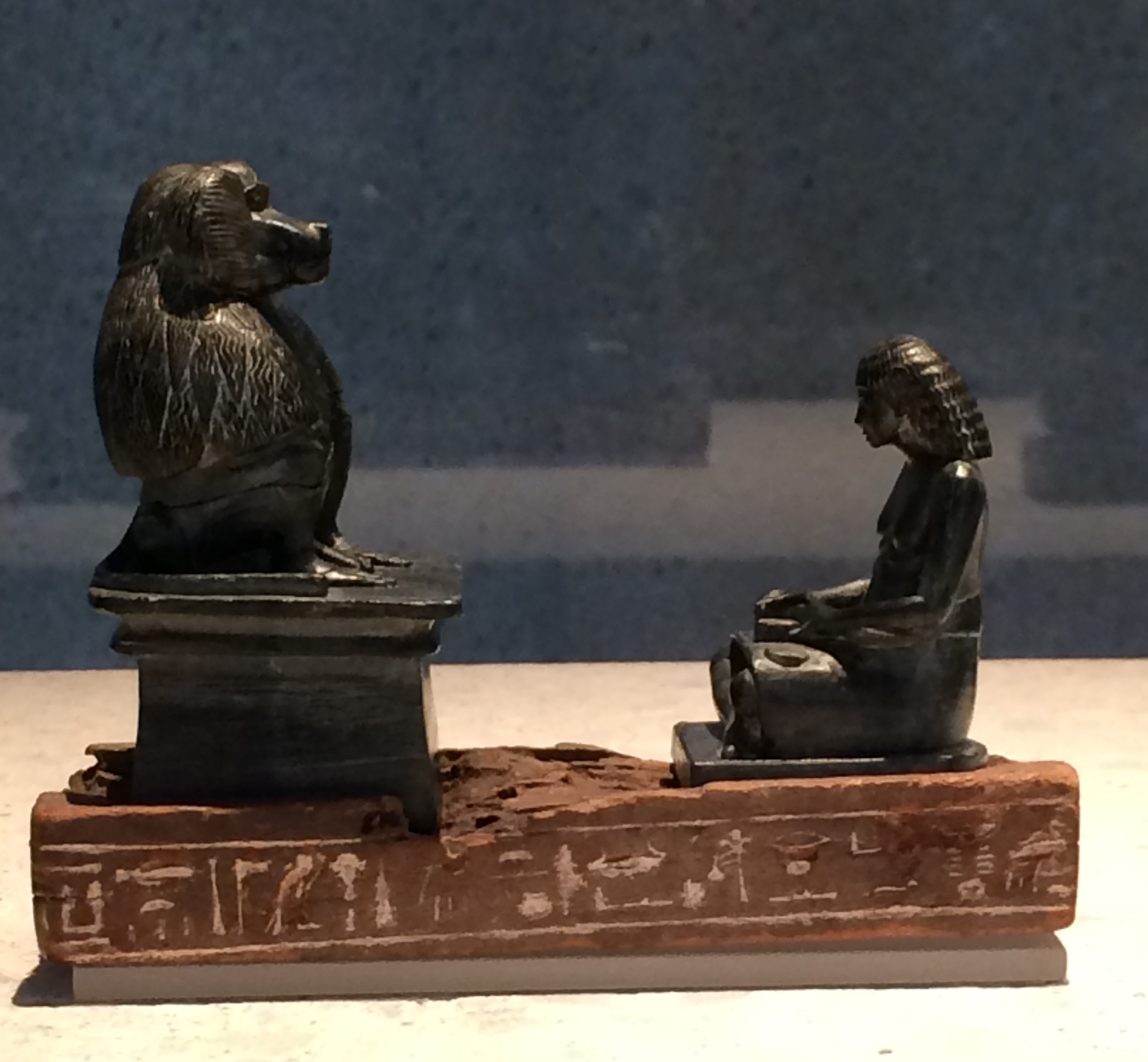
The scribe Tjaj in front of the god Thoth, patron of scribes, in the shape of a baboon. (New Kingdom, late 18th Dynasty, Amenophis III (?), 1388-1351 BC; collection of Neues Museum Berlin)
As some of my readers may know, the past year has seen a gradual shift away from formal journalism and toward more creative, personally fulfilling arenas. The precise nature of such a destination has yet to manifest or clarify itself, but, trusting the path, as they say, often brings the most important discoveries, whether we like them or not. Liking, much less being comfortable, isn’t so much the point, but evolving is.
One stage in that evolution has been taking a conscious step away from writing reviews. In Daniel Mendelsohn’s brilliant 2012 New Yorker essay about critics, he notes that “(t)he role of the critic […] is to mediate intelligently and stylishly between a work and its audience; to educate and edify in an engaging and, preferably, entertaining way.” Mendelsohn, Editor at Large of the New York Review of Books, writes with engaging specificity about how the work of certain critics from his youth inspired his curiosity: “I thought of these writers above all as teachers, and like all good teachers they taught by example; the example that they set, week after week, was to recreate on the page the drama of how they had arrived at their judgments. ” We all find our own in-roads when it comes to culture: the influence of people we are raised by; the big and small events we experience as children; the sounds and sights and smells and surfaces we absorb intellectually, emotionally, spiritually through the various facets that carry us into and through adulthood. Social influence, of course, has taken on a life of its own within the digital age, with the culture of “like” and “favorite” occasionally (Mendelsohn might argue too often) taking the place meaningful criticism might have occupied in the past. There’s also the pervasive (and now normalized) trinity of programming, pageviews, and promotion that have become sticky symbols of, among other things, the contemporary force of clickbait. A music historian friend of mine refuses to hit “like” on most things he sees on Facebook, whether he truly enjoys such posts or not, his reasoning that inspiration, and personal taste for that matter (something Mendelsohn mentions frequently), shouldn’t be reduced to algorithmic slavery. He has a point.
All of which is to say, criticism still matters, but instead of writing reviews myself, I’m going to help others do it. As of January 2020, I’ll be part of the Emerging Arts Critics panel, a Canada-based program that aims to mentor the next generation of culture writers in partnership with a variety of Toronto-based media and arts institutions including Opera Canada magazine (to which I am a frequent contributor) and the Canadian Opera Company. I may no longer review opera, but I am happy to be teaching the next generation. I’m equally happy to point out interesting figures whose work, while uncritical, inspires that all-important cultural curiosity, while providing fun bursts of inspiration and education; classical music writer and enthusiast Jari Kallio is one of those people. Known to the online classical community for his deep knowledge and refreshing lack of pretension, the well-travelled Finn documents what he sees, listens to, and studies at regular intervals. His posts aren’t intended to provoke reactivity (namely those 21st century digital diseases like hate-likes or juvenile jealousies) but are meant to inspire and educate, and sometimes entertain too.
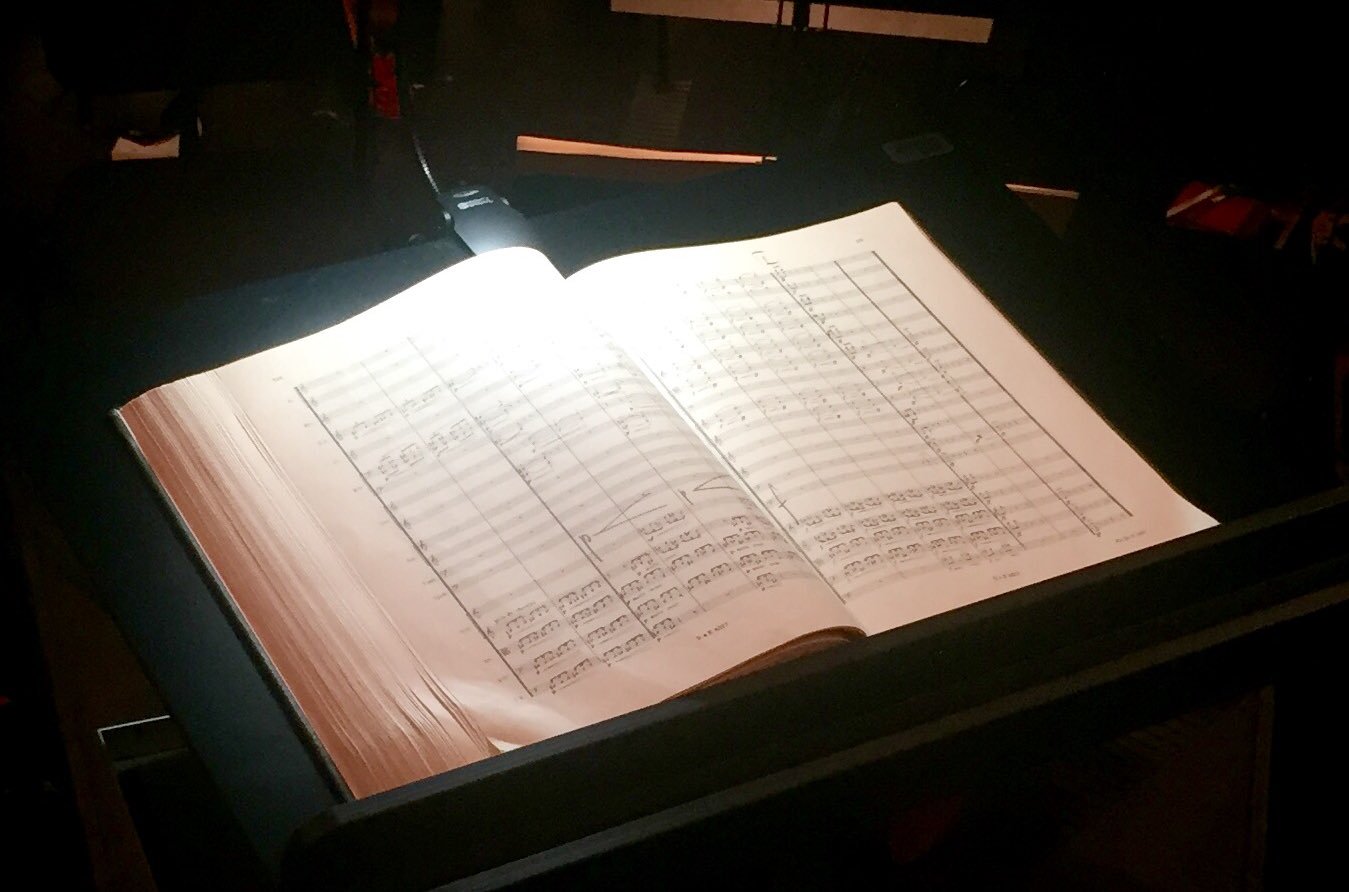
Esa-Pekka Salonen’s score for Pelléas et Mélisande. Photo: Jari Kallio
It would be easy to dismiss Jari as a cheerleader. When he likes something (or someone), it is obvious. He does not make a secret of his favorites, but in an age where the fandom of Anna Netrebko is loud and boisterous, it’s nice to see that spirit being so vigorously applied to artists like Harrison Birtwistle, Oliver Knussen and Jörg Widmann. Having worked as a teacher of psychology and philosophy for over two decades in pre-university studies for students sixteen to nineteen in Finland, Jari has a natural ability to be as direct with his language as he is clear in his contextualizing. Well-versed in music new and old, he considers score-reading to be a natural extension of his ever-unfolding education as well as an expression of his intense creative curiosity. Those qualities lend him an authority which can often be seen in his online exchanges with fellow music lovers, ones which are wonderfully free of patronizing and condescension, and offer in-roads for those new to classical music. Clearly aware of the culture of the internet, his Twitter and Instagram feeds regularly feature playful comments and humorous shots of both himself and his cat, Nono (yes, named after the Italian composer). If one wants to apply the term “blogger,” I suppose one could, but the term feels somehow too small for his wide-ranging curiosities, and too limiting for his talents. He’s not a singular figure for his cultural pursuits, but he is one of the most earthy in their expression.
Our conversation here marks the first of what I hope will become regular exchanges with digitally-savvy classical music writers. There’s value, and some manner of delight, in conversing with such ambassadors and educators in a rapidly-changing art form. And so, to my original point, that making a conscious choice to change one’s path without knowing the final destination isn’t meant to always be a comfortable process. Indeed. Jari’s posts sometimes provoke sharp stabs of shrieking panic (mainly of not knowing nearly enough about our shared passion) but it’s a reaction softened by a calm, more sustained voice whispering that it’s never too late to learn; the willingness is all. Back in June, Jari and I enjoyed a lovely, wide-ranging chat – about score reading, contemporary composers, the joys of attending rehearsals, and the connection between Star Wars and Sibelius. Enjoy.
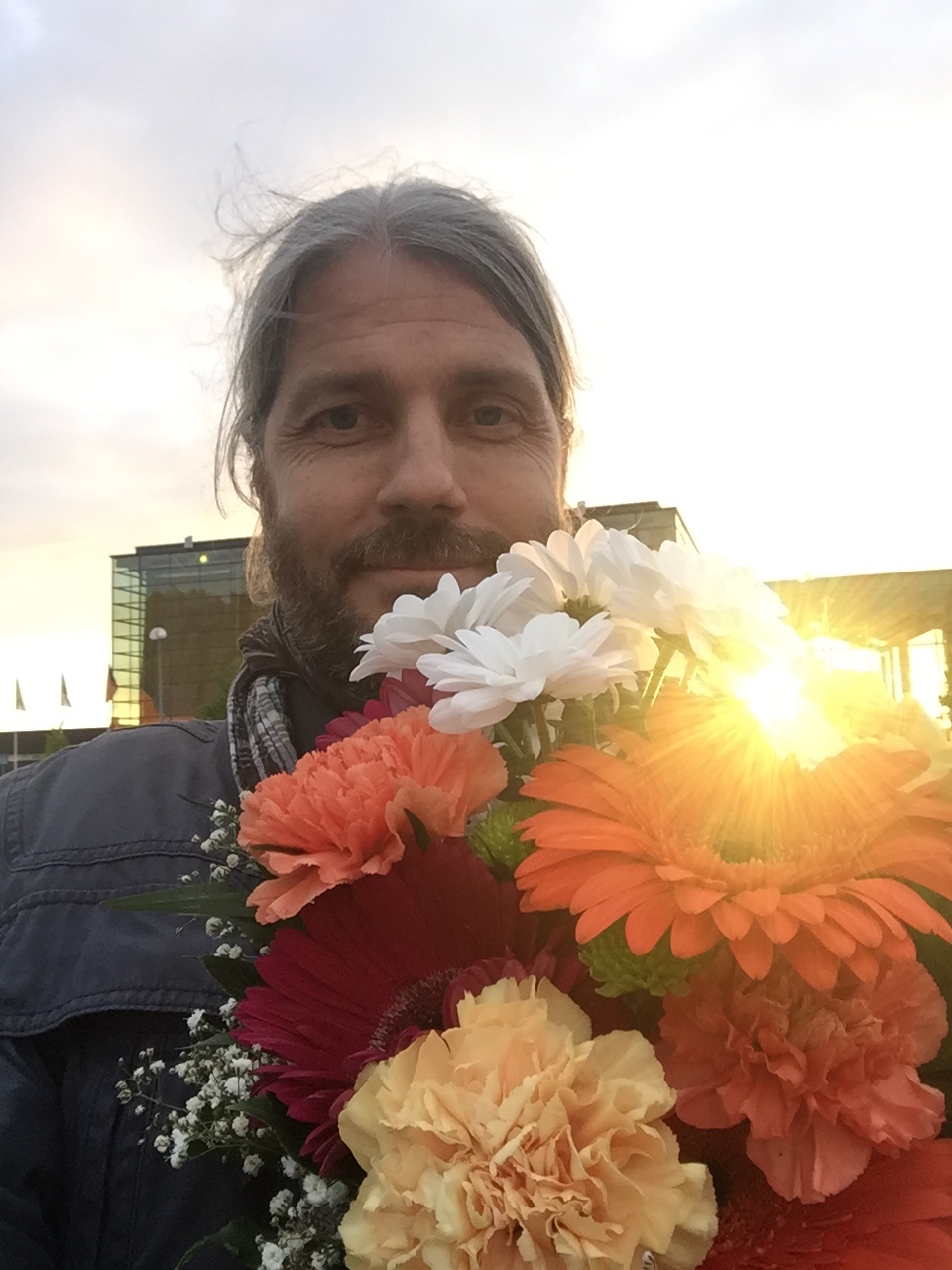
Photo courtesy Jari Kallio.
Do you find your music passion seeps into your teaching life? I’ve introduced things like leitmotifs within a project-specific context, so students can then apply that concept.
Yes, I do that too! For example, in psychology there are so many things you can work out through pieces of art and music, so basically that’s an endless source for cases and examples and allegories…
… and concepts, and inspiring people to understand things and experience things in a new way…
Exactly.
Speaking of new ways, you found your own path into music, yes?
I didn’t go to a conservatory but I took piano lessons for three or four years, and when I studied psychology as a major, I did some musicology and history of music as a second subject. From my teens is when it all got started. I’m from a working-class family, and there’s musicality in my family, but it comes from my father’s side. My grandfather was quite a good amateur player – he had a good ear. He could pick out tunes from the radio and play them; he was really good at it. My father had some of that too, but he played very little, and so in their world, there wasn’t a thing like music education; yes, it would’ve been available, but it was something rather unknown to them.
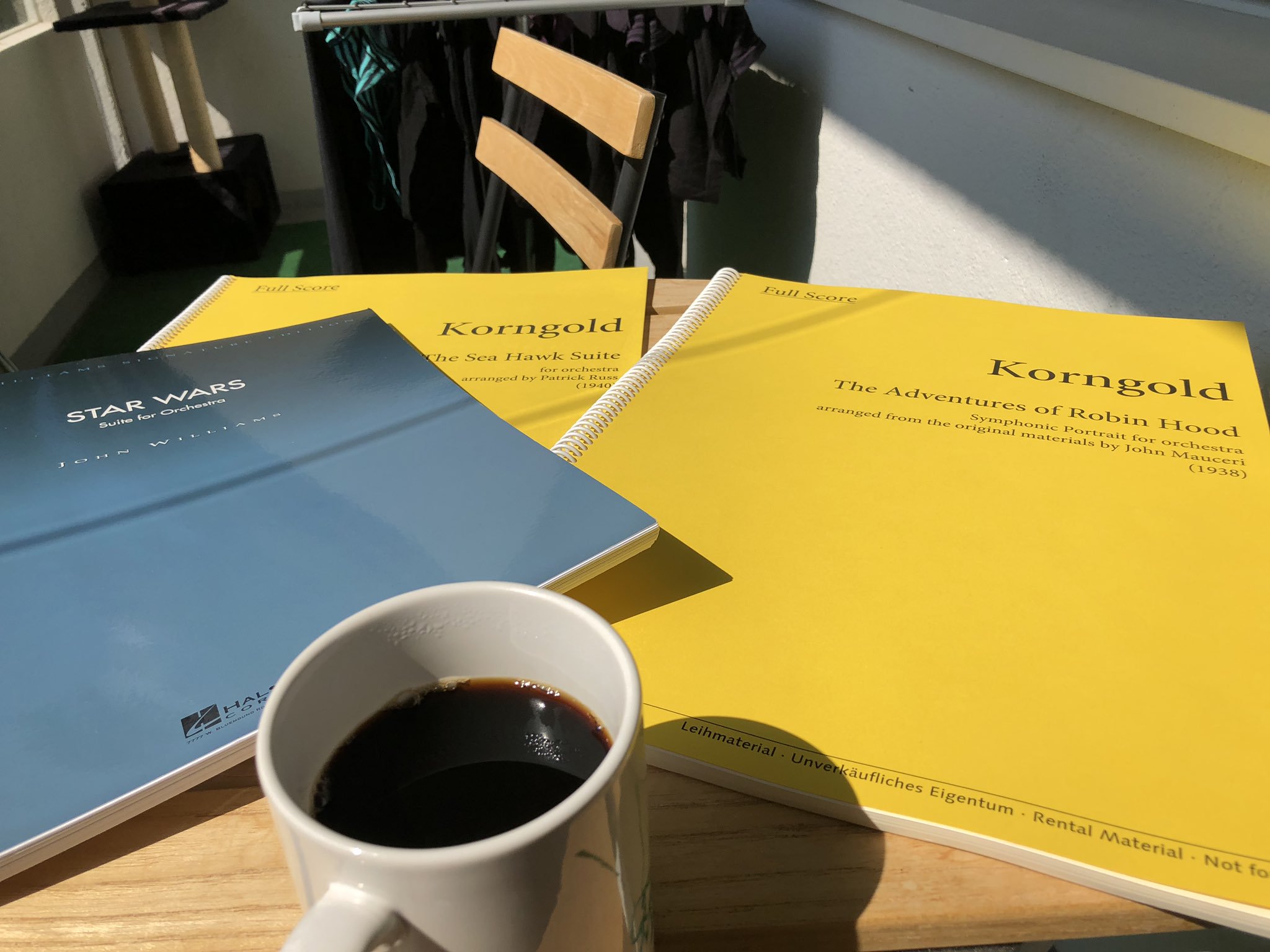
Photo: Jari Kallio
That sounds a lot like my mother; she came from a working-class background as well and only seemed to know the Conservatory as it related to my yearly piano exams.
Exactly! I had very few early influences though, apart from school. In my first year at school in Finland – we start school at the age of seven – I remember our city orchestra, which was a small, 25-piece orchestra, paid a visit to our school. That was the first time I’d heard an orchestra live. They played some orchestral music, and the only piece I remember from that is Sibelius, his Karelia music, the intermezzo. It was such a huge thing to hear, and that’s the early thing which got me curious. And then, being of my generation, which is the Star Wars generation, I of course picked up John Williams’s music for the film, which was actually the first thing I had on a physical record. In my teens I suddenly started discovering more, and at some point I just felt I had to try to play something, so I did a couple of years of piano lessons and soon realized that I’m not much of a player. That never bothered me because I learned to read music and got kind of an understanding of how music works, performance-wise, which I think was very important. I picked up my first scores when I was about eighteen or nineteen.
What inspired you to delve into scores as a non-musician?
I was really curious to see how the music works, what happens on the page, how does it look? It was the fascination of seeing scores at the conductor’s podium and being really interested in seeing what they see, what do they look at, what is the source? So at first it was simply curiosity, and kind of like, can I read through it? Can I follow a performance from it? It was a challenge.
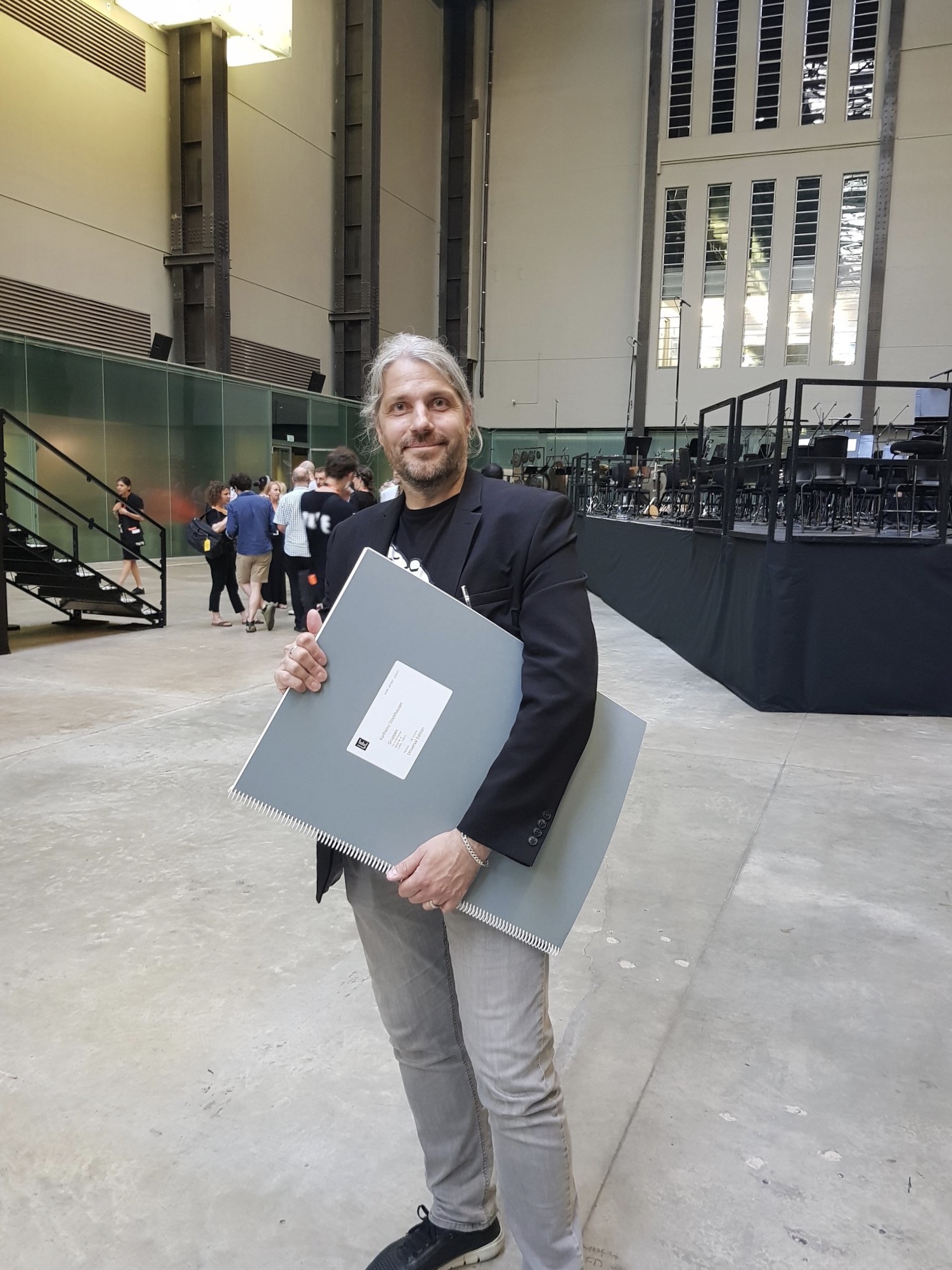
At the Tate Modern Turbine Hall with the score for Stockhausen’s Gruppen, June 2018. Photo: Jo Johnson, Senior Marketing Manager, Digital Communications, London Symphony Orchestra
What was the first score you bought?
I bought cheap editions of Brahms’ Fourth Symphony and Debussy’s “La Mer.” In Helsinki, there’s a music shop that sells records and scores and they had these score on sale, and I went there with what little student money I had back then and I found these two, and I thought they were brilliant.
How many do you have now?
I haven’t really counted them, but I’d say something like 200 to 250 or so.
You take a particular interest in new music.
Finland has a great scene for contemporary music and not just special ensembles but for large orchestras. They all do it – they’ve been doing it for a very long time. It’s something really organic, it’s not just (orchestras) commissioning short pieces and force-feeding the audience; it’s an essential part of the programming. And interestingly, in Helsinki for example, many of the concerts that feature new music sell really well and really fast. They are very often the first concert that are sold out, which is really interesting.
Why do you think that is?
I think in a sense, it originally comes from the fact that the first Finnish orchestras were established in the late 19th century; from early on they played music like Sibelius and all the Finnish composers. (Orchestras and composers) were part of the Finnish independence movement at the time, so it became a natural part of our culture. Also, because we are here at the border of Europe, we don’t have such a long (classical) tradition; the first Finnish orchestra of music comes from the latter half of the 19th century. We weren’t burdened by tradition, so to speak, and that liberated the programming, which is a great thing. Many (living Finnish composers) are definitely well known outside Finland – Salonen and Saariaho and Sebastian Fagerlund, for example. There are really so many great new composers.
What sorts of things do you think new music provides the listener?
It might sound clichéd, but the first thing that pops into my mind is that it gives purpose, in the sense of discovery. It’s really hard to express in words, but especially with new music, I think it’s the pleasure of discovery. When you listen to a lot of music, you start to get the idea that there are sort of these black areas on the map – between styles, between pieces, these undiscovered territories – and then you hear something somebody has written, and it goes to that undiscovered territory. You hear something which is totally new, which totally opens a new view. That, in a sense, is one of the most rewarding things. And also with the older repertoire, I mean, the pleasure of music is that you can perform the same piece of music a thousand times differently and it can be fresh and new every time. This season I heard St. John Passion in Berlin, dramatized by Peter Sellars and conducted by Sir Simon Rattle, and it showed totally different aspects to a classic piece. I think, if you get the impression that, “this is the most important thing at this precise moment, the thing I want to focus on…” then that’s a good concert.
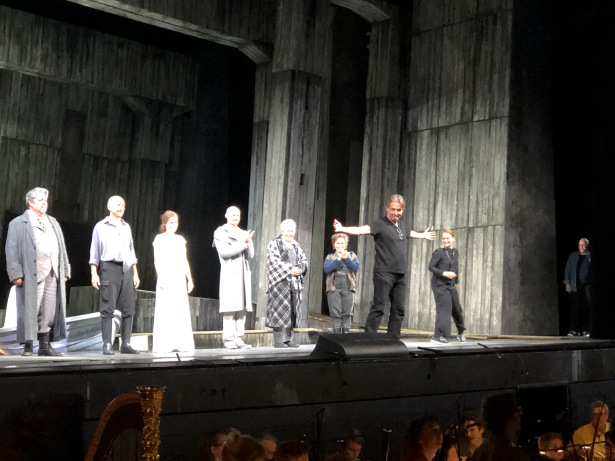
Esa-Pekka Salonen during rehearsals for Pelléas et Mélisande at the Finnish National Opera, spring 2019. Photo: Jari Kallio
Yet you also delve into rehearsal work as well; your behind-the-scenes report on Pelléas et Mélisande at the Finnish National Opera with Salonen, for example, were fascinating.
That was a lot of fun to do, to spend two weeks there. I’ll be covering the time when Salonen starts his first Ring Cycle at the Finnish National Opera – they’re doing Das Rheingold in August – and I have a couple of other projects in mind. For instance, Rattle is doing Idomeneo at the Staatsoper Berlin, so I might try to cover that. Obviously, it’s an important thing to review concerts, but it’s been done for ages. I know this might sound a bit pompous, but in a sense, I think that a critic (preserves) a memory – he or she documents something in the past…
… and evaluates it within various contexts for the present.
Usually yes! But I think it’s very important that the wider public understands how a performance is put together. What does it take? What is all the hard work done before the performance? This is so people can truly appreciate and understand how the thing is built. And of course, on a personal level, the best way to learn is to go to rehearsals and follow them and really try to get a hold of the thing.
From the very few I’ve attended, I find I re-discover, re-evaluate – and explore entirely new things as well. I’d love to attend more rehearsals.
With more experience you gain more levels of listening. What you hear in rehearsals – the process of creating music – is really the most rewarding part. Sometimes I have the feeling after attending a series of rehearsals I could easily skip the concert itself! I think one of highest fascinating and rewarding things was last year in January, when I attended a series of rehearsals by the LSO and Simon Rattle; they were doing the Berg Violin Concerto with Isabelle Faust as soloist. Within the three days I heard that piece, they played it something like four or five times through, and worked on it and worked on it. I had known the piece for roughly twenty years or something, but hearing it that way was really amazing.
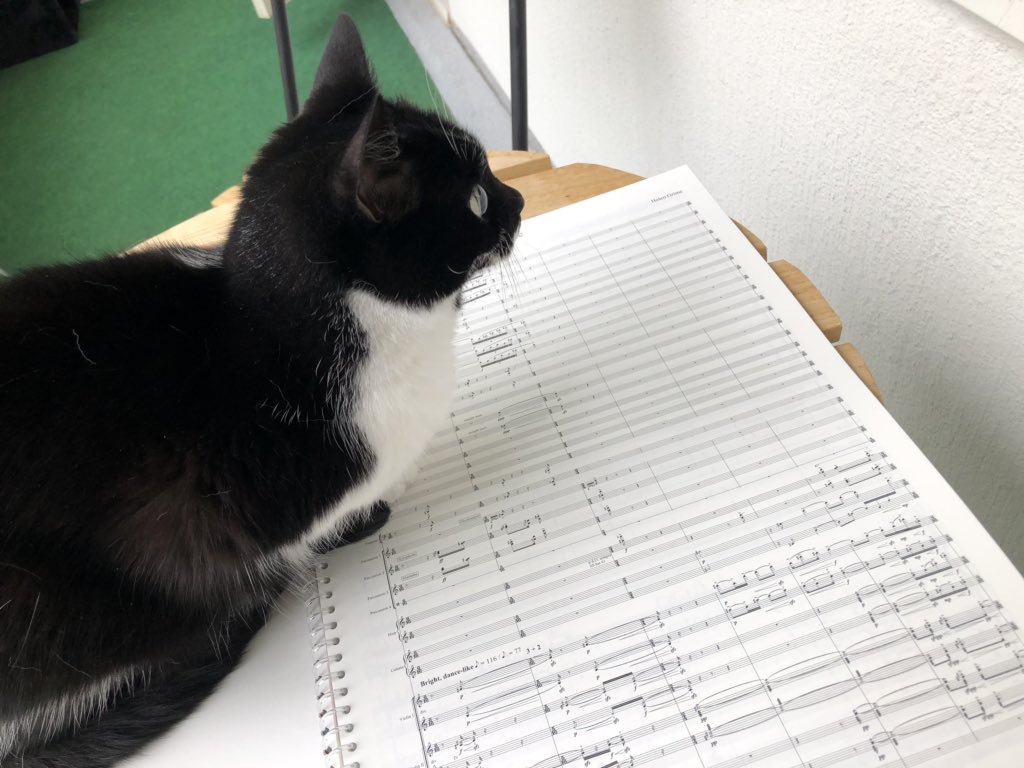
Nono the cat. Photo: Jari Kallio
It often feels as if you provide a way into sometimes challenging pieces and composers through your updates on these processes, demystifying what is, for many, a rather daunting thing.
I hope so – that’s the point, really! When I started my writing career nineteen years ago, I worked as a full-time, jack-of-all-trades journalist for a year, and of course initially you are really excited to see your work in print, like “WOW!” But as time goes by, that feeling wears off and you really start to think about the most important thing: readers, the public. You are writing for someone, not just to please yourself. You have to think: what’s the point of doing this? What do I want to say and emphasize? If somebody reads my stuff, and if they are in some way inspired or informed, I’m really happy and pleased.

Essay: “She Had A Choice”
By Catherine Kustanczy
On August 13, 2019
In classical, music, opera, personal
Today’s news about Placido Domingo was shocking to some and not to others. I spent much of the day pouring over various reactions, curious to take the temperature of the online classical world. What was and is most striking throughout various forums I read has been the divisive nature of the comments, sharply moving between “finally” and “bunch of lying opportunists.” Addressing this in writing offers a rumination on something I’ve not commented on very much publicly. I’m not one to shriek about anything on social media (those who know me know I do that enough in-person over anything I feel strongly about), but with news of one of the most famous living opera figures being accused of sexual harassment, the time feels nigh, and so.
I met Placido Domingo as a wide-eyed child who was pulled out of school to attend a record store one blustery Toronto afternoon. My mother smiled graciously when it came to be our turn. I only later understood the looks exchanged between the tenor and my starstruck (if very beautiful) mother. He told me to “study hard” and off we went. Years later my mother and I would watch Three Tenors concerts now and again, and after her passing, I got to see Domingo myself, in a concert version of Thais at the Salzburg Festival, and later in Macbeth at LA Opera. In any business the reality of transaction is part of overall functionality; scratch my back, I scratch yours. Within the arts world there exists, with equal if not greater presence, a spirit of what I’d call relationality, where the bonds of positive relationships power much of what is experienced within a live performance, in opera or in concert. Those relationships are, quite often, sacred things, creating webs-within-webs of connectivity between artists, administrators, musicians, designers, directors, managers, dramaturgs, répétiteurs, and the many, many others who help to make classical things happen. Transactionality, and more vitally, relationality, create a frequent blurring between art and life, a blur which often manifests itself in some of the most magical and unexpected ways, but within that world, there are barriers people (professionals, that is) know not to cross. Others – those in positions of power – step over the lines without a second thought; they know they can. Power affirms a feeling of impunity, entitles poor behaviour, highlights narcissism. When your norm is applause and adoration, you don’t care about blurring lines, because the rules don’t apply. This, of course, is where abuse happens.
Photo: mine. Please do not reproduce without permission. (Collection Bode-Museum, Berlin)
Those who’ve been shrieking about opportunistic ingenues tend to point directly at Instagram as evidence of their claims, and while one might suspect any number of young artists would happily go to some effort to meet such powerful (and obviously useful) men, in this age of carefully curated selfies and meticulously groomed feeds, yes, sex sells, and always has; the classical world is not immune. (In working on a story about Instagram and opera last year, one friend commented that the platform has become “one giant competition to see which ingenue can pout the hardest –never mind the singing.”) It could be reasonably said that young women in the arts are more empowered than ever when it comes to presenting the image they wish the world to see; there are others who claim they’ve experienced instances of ingenues coming on to those in power (directors, conductors, major leads). I would argue such instances are perfect examples of women feeling they need to play into a male-gaze game for professional advancement. But, you may say, isn’t that how the world works? My question is, why should it have to be in 2019?
In my own younger days, I was agog at any attention from men whose work I enjoyed; they were indeed gods to me. (One of Domingo’s accusers speaks of him in similar terms.) Yes, it’s dangerous to put people on pedestals, but it happens with predictable regularity in the arts world, and it can be hard to see our heroes as fallible beings who are capable of screw-ups, let-downs, and generally terrible behaviour. When I was the receiving end of some flirtation by a famous man in my 20s, I remember being flattered, stunned, bewildered (“he’s paying attention to little old me?!“) – it was a sort of high I didn’t want to come down from. I did not possess the maturity or self-confidence to be able to discern whether or not such attentions were appropriate or sincere; I only knew it was exciting, addictive, and good at quelling the blizzard of negative inner voices, all of them crying for validation. If such validation happened to be coming from the object of worship… what better thing? I felt I was getting ahead; I felt, as a twenty-something stuck in a series of dead-end jobs, I was finally progressing. I felt the true me was being heard, seen, accepted, celebrated. Of course, it wasn’t the “true me” at all that was being recognized but the part handy to the powerful man. I gave away a version of myself, quickly and freely, in exchange for the validation I thought I needed, the feeling of advancement conflated with acceptance and affection with equal determination.
Photo: mine. Please do not reproduce without permission. (Collection Altes Museum, Berlin)
It’s tough when the only arena in which you might hope to experience intimacy (or its fantasy-laden pastiche) is a transactional one. Some powerful men will, quite purposefully, sing a siren’s song to one’s doubting inner voices, a song that promises success, wholeness, joy, that says “I can give you all this…“. Attention, flirtation, the promise of success: narcotics for a young woman with a shaky sense of both herself and her worth. It’s hard to say “no” to all of that. It’s hard to say “no” to someone you idolize, who is powerful, who says he’ll help you, who convinces you that he thinks you’re talented and sexy and brilliant. It’s hard to say “no” to the attentions of a powerful man when you, as a young woman in a far less advantageous position, feel you need those attentions, and you need to accept them to climb the ladder of success. You don’t recognize you’re being groomed because you don’t have the tools for that, much less to refuse and walk away. And even if you do recognize the predatory nature of the attention, what “choice” do you actually have? Would it be right to call it “consent”?
The use of that word has been widespread in today’s online discussions. I take particular issue with its misuse because it begs the question: from which environment — mental, emotional, intellectual, societal — does that consent arise? From which vantage point? From whose history? From which influences? A woman’s history with that word, and its power in her life (to say nothing of the culture in which she was raised), may have taught her to think of it in ways that are the precise opposite of its true meaning and lived application, thus leading to a deep internalization of patriarchal notions of power – who holds it, why, how. So I ask again: whose consent? In what spirit was such consent made and given? Was it even a conscious decision, made with the full faculties of reason, rationality, maturity, and experience? “Consent is consent!” some may argue, “Stop twisting things!”
Photo: mine. Please do not reproduce without permission. (Collectiion Bode-Museum, Berlin)
But the situation itself is twisted, because current ideas of who holds power and why have been internalized to the point of a total blindness that does not and literally cannot allow for empathy (which extends to much of the current political discourse as well). The perception of what true consent actually is, in and of one’s self, is (and was) a ridiculously complicated (though it shouldn’t be) matter when one is starting out in a notoriously difficult industry which, in itself, is adverse to change and evolution. A woman may be “consenting” because she feels there’s no other path. She may be “consenting” because she truly believes this is just how things are done, and have been done, in the industry. She may “consent” because she was raised in a culture that says men are always horny, always the boss, and always have more power than you. She may be “consenting” because the idea of courting rejection from someone she idolizes is too painful to bear, her sense of self being so closely tied up and twisted with the person she’s presented – and it may well be career suicide to say “no.” From what I’ve read today there are a number of people who simply don’t comprehend the vast power of someone like Placido Domingo – though there are just as many who do; there isn’t real “choice” in dealing with someone who has sat so high, for so long, on the throne of his own classical kingdom. Failure to recognize this constitutes the worst form of ignorance, willful or not. The exercise of choice within such a context is illusory at best. A powerful man can sometimes be very clear about the sex-in-exchange-for-opportunities thing, and so a young woman’s choice (so-called) between offering sexual favors to ascend professionally, and not having any professional opportunities at all, is hardly a climate in which any human should be expected to operate. It certainly isn’t one in which the notions of choice and consent can be freely exercised.
Photo: mine. Please do not reproduce without permission. (Collection Bode-Museum, Berlin)
I want to believe that human evolution is moving far past a place where sexual transactionality within the classical industry is perceived as normal and fine and even (good grief) empowering for women. I believe serious damage – creative, emotional, spiritual – is being wrought through the perpetuation of a casting-couch culture, a damage only felt decades down the line, as women face the fallout of their perceived choices, ones made for reasons wholly unconnected with true advancement. New worlds are opening up as more people feel emboldened to come forwards and say: I don’t accept this as our system. This is not the key we should play in; this is not the aria we should continue to sing. This tempo stinks; let’s rewrite the whole thing together.
It takes a lot, to risk saying this in public, much less living it –to risk being perceived as a flake, a golddigger, a finger-wagger, an apologist, a malicious figure of angry embitterment. One must continually acknowledge that we operate within a system that’s been set up with the most strict and narrow conventions (of race, sex, opportunity), but we love the classical arts enough to push for change. It is a risk, and a reward, to be truly heard, seen, recognized, accepted for who one is, without the thousand masks we wield on a daily basis to please our respective audiences. To the ladies who spoke up: thank you, and encore.
Top photo: Sculpture from Bode Museum, Berlin; mine. Please do not reproduce without permission.